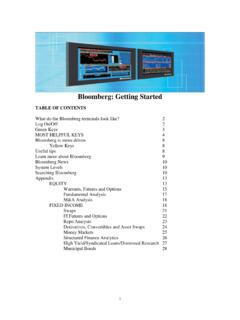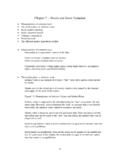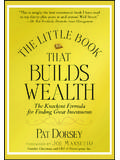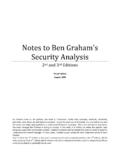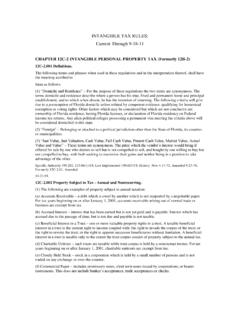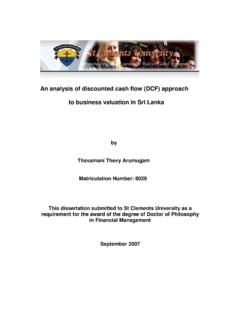Transcription of CHAPTER 6 Common Stock Valuation - by Jan Röman
1 CHAPTER 6. Common Stock Valuation A fundamental assertion of finance holds that a security's value is based on the present value of its future cash flows. Accordingly, Common Stock Valuation attempts the difficult task of predicting the future. Consider that the average dividend yield for large-company stocks is about 2 percent. This implies that the present value of dividends to be paid over the next 10 years constitutes only a fraction of the Stock price. Thus, most of the value of a typical Stock is derived from dividends to be paid more than 10 years away! As a Stock market investor, not only must you decide which stocks to buy and which stocks to sell, but you must also decide when to buy them and when to sell them. In the words of a well- known Kenny Rogers song, You gotta know when to hold em, and know when to fold em. This task requires a careful appraisal of intrinsic economic value. In this CHAPTER , we examine several methods commonly used by financial analysts to assess the economic value of Common stocks .
2 These methods are grouped into two categories: dividend discount models and price ratio models. After studying these models, we provide an analysis of a real company to illustrate the use of the methods discussed in this CHAPTER . 2 CHAPTER 6. Security Analysis: Be Careful Out There It may seem odd that we start our discussion with an admonition to be careful, but, in this case, we think it is a good idea. The methods we discuss in this CHAPTER are examples of those used by many investors and security analysts to assist in making buy and sell decisions for individual stocks . The basic idea is to identify both undervalued or cheap stocks to buy and overvalued . or rich stocks to sell. In practice, however, many stocks that look cheap may in fact be correctly priced for reasons not immediately apparent to the analyst. Indeed, the hallmark of a good analyst is a cautious attitude and a willingness to probe further and deeper before committing to a final investment recommendation. The type of security analysis we describe in this CHAPTER falls under the heading of fundamental analysis.
3 Numbers such as a company's earnings per share, cash flow, book equity value, and sales are often called fundamentals because they describe, on a basic level, a specific firm's operations and profits (or lack of profits). (marg. def. fundamental analysis Examination of a firm's accounting statements and other financial and economic information to assess the economic value of a company's Stock .). Fundamental analysis represents the examination of these and other accounting statement- based company data used to assess the value of a company's Stock . Information, regarding such things as management quality, products, and product markets is often examined as well. Our cautionary note is based on the skepticism these techniques should engender, at least when applied simplistically. As our later CHAPTER on market efficiency explains, there is good reason to believe that too-simple techniques that rely on widely available information are not likely to yield systematically superior investment results.
4 In fact, they could lead to unnecessarily risky investment Common Stock Valuation 3. decisions. This is especially true for ordinary investors (like most of us) who do not have timely access to the information that a professional security analyst working for a major securities firm would possess. As a result, our goal here is not to teach you how to pick stocks with a promise that you will become rich. Certainly, one CHAPTER in an investments text is not likely to be sufficient to acquire that level of investment savvy. Instead, an appreciation of the techniques in this CHAPTER is important simply because buy and sell recommendations made by securities firms are frequently couched in the terms we introduce here. Much of the discussion of individual companies in the financial press relies on these concepts as well, so some background is necessary just to interpret much commonly presented investment information. In essence, you must learn both the lingo and the concepts of security analysis.
5 CHECK THIS. What is fundamental analysis? What is a rich Stock ? What is a cheap Stock ? The Dividend Discount Model A fundamental principle of finance holds that the economic value of a security is properly measured by the sum of its future cash flows, where the cash flows are adjusted for risk and the time value of money. For example, suppose a risky security will pay either $100 or $200 with equal probability one year from today. The expected future payoff is $150 = ($100 + $200) / 2, and the security's value today is the $150 expected future value discounted for a one-year waiting period. 4 CHAPTER 6. If the appropriate discount rate for this security is, say, 5 percent, then the present value of the expected future cash flow is $150 / = $ If instead the appropriate discount rate is 15 percent, then the present value is $150 / = $ As this example illustrates, the choice of a discount rate can have a substantial impact on an assessment of security value. A popular model used to value Common Stock is the dividend discount model, or DDM.
6 The dividend discount model values a share of Stock as the sum of all expected future dividend payments, where the dividends are adjusted for risk and the time value of money. (marg. def. dividend discount model (DDM) Method of estimating the value of a share of Stock as the present value of all expected future dividend payments.). For example, suppose a company pays a dividend at the end of each year. Let D(t) denote a dividend to be paid t years from now, and let V(0) represent the present value of the future dividend stream. Also, let k denote the appropriate risk-adjusted discount rate. Using the dividend discount model, the present value of a share of this company's Stock is measured as this sum of discounted future dividends: D(1) D(2) D(3) D(T). V(0) ' % % % % [1]. (1 % k) (1% k) 2. (1 %k) 3. (1% k)T. This expression for present value assumes that the last dividend is paid T years from now, where the value of T depends on the specific Valuation problem considered. Thus if, T = 3 years and D(1) = D(2) = D(3) = $100, the present value V(0) is stated as $100 $100 $100.
7 V(0) ' % %. (1 %k) (1% k) 2. (1 %k)3. Common Stock Valuation 5. If the discount rate is k = 10 percent, then a quick calculation yields V(0) = $ , so the Stock price should be about $250 per share. Example Using the DDM. Suppose again that a Stock pays three annual dividends of $100 per year and the discount rate is k = 15 percent. In this case, what is the present value V(0) of the Stock ? With a 15 percent discount rate, we have $100 $100 $100. V(0) ' % %. 2. ( ) ( ) ( )3. Check that the answer is V(0) = $ Example More DDM. Suppose instead that the Stock pays three annual dividends of $10, $20, and $30 in years 1, 2, and 3, respectively, and the discount rate is k = 10 percent. What is the present value V(0) of the Stock ? In this case, we have $10 $20 $30. V(0) ' % %. 2. ( ) ( ) ( )3. Check that the answer is V(0) = $ Constant Dividend Growth Rate Model For many applications, the dividend discount model is simplified substantially by assuming that dividends will grow at a constant growth rate.
8 This is called a constant growth rate model. Letting a constant growth rate be denoted by g, then successive annual dividends are stated as D(t+1) = D(t)(1+g). (marg. def. constant growth rate model A version of the dividend discount model that assumes a constant dividend growth rate. For example, suppose the next dividend is D(1) = $100, and the dividend growth rate is g = 10 percent. This growth rate yields a second annual dividend of D(2) = $100 = $110, and 6 CHAPTER 6. a third annual dividend of D(3) = $100 = $100 ( )2 = $121. If the discount rate is k = 12 percent, the present value of these three sequential dividend payments is the sum of their separate present values: $100 $110 $121. V(0) ' % %. 2. ( ) ( ) ( )3. ' $ If the number of dividends to be paid is large, calculating the present value of each dividend separately is tedious and possibly prone to error. Fortunately, if the growth rate is constant, some simplified expressions are available to handle certain special cases.)
9 For example, suppose a Stock will pay annual dividends over the next T years, and these dividends will grow at a constant growth rate g, and be discounted at the rate k. The current dividend is D(0), the next dividend is D(1) = D(0)(1+g), the following dividend is D(2) = D(1)(1+g), and so forth. The present value of the next T dividends, that is, D(1) through D(T), can be calculated using this relatively simple formula: T. D(0)(1%g) 1%g V(0) ' 1 & g k [2]. k &g 1%k Notice that this expression requires that the growth rate and the discount rate not be equal to each other, that is, k g, since this requires division by zero. Actually, when the growth rate is equal to the discount rate, that is, k = g, the effects of growth and discounting cancel exactly, and the present value V(0) is simply the number of payments T times the current dividend D(0): V(0) ' T D(0) g ' k Common Stock Valuation 7. As a numerical illustration of the constant growth rate model, suppose that the growth rate is g = 8 percent, the discount rate is k = 10 percent, the number of future annual dividends is T = 20 years, and the current dividend is D(0) = $10.
10 In this case, a present value calculation yields this amount: 20. $10( ) V(0) ' 1 &..10& .08 ' $ Example Using the Constant Growth Model. Suppose that the dividend growth rate is 10 percent, the discount rate is 8 percent, there are 20 years of dividends to be paid, and the current dividend is $10. What is the value of the Stock based on the constant growth model? Plugging in the relevant numbers, we have 20. $10( ) V(0) ' 1 &..08& .10 ' $ Thus, the price should be V(0) = $ Constant Perpetual Growth A particularly simple form of the dividend discount model occurs in the case where a firm will pay dividends that grow at the constant rate g forever. This case is called the constant perpetual growth model. In the constant perpetual growth model, present values are calculated using this relatively simple formula: D(0)(1%g). V(0) ' g < k [3]. k& g 8 CHAPTER 6. Since D(0)(1 + g) = D(1), we could also write the constant perpetual growth model as D(1). V(0) ' g < k [4]. k& g Either way, we have a very simple, and very widely used, expression for the value of a share of Stock based on future dividend payments.



